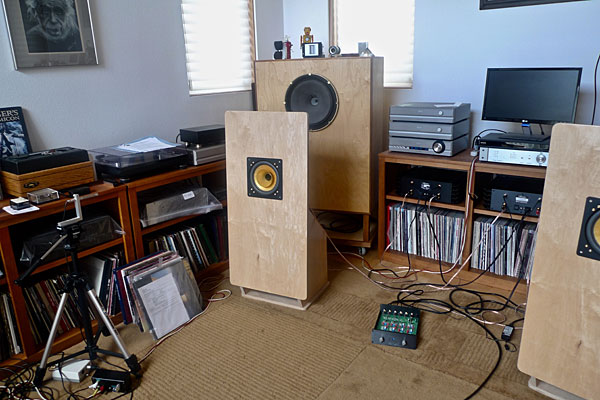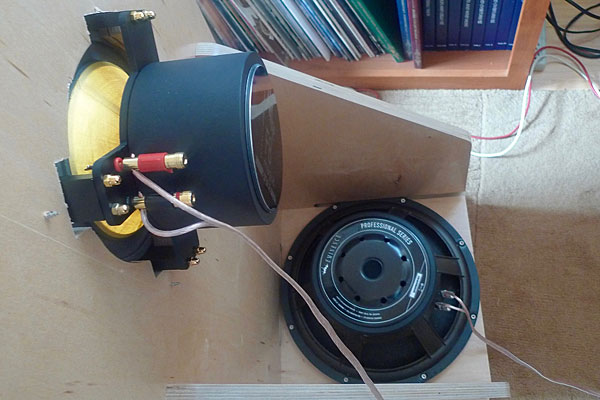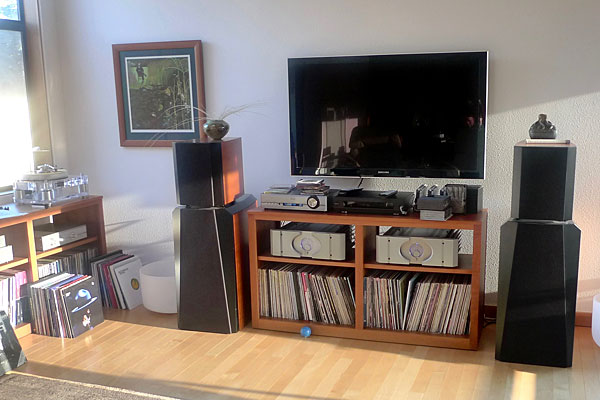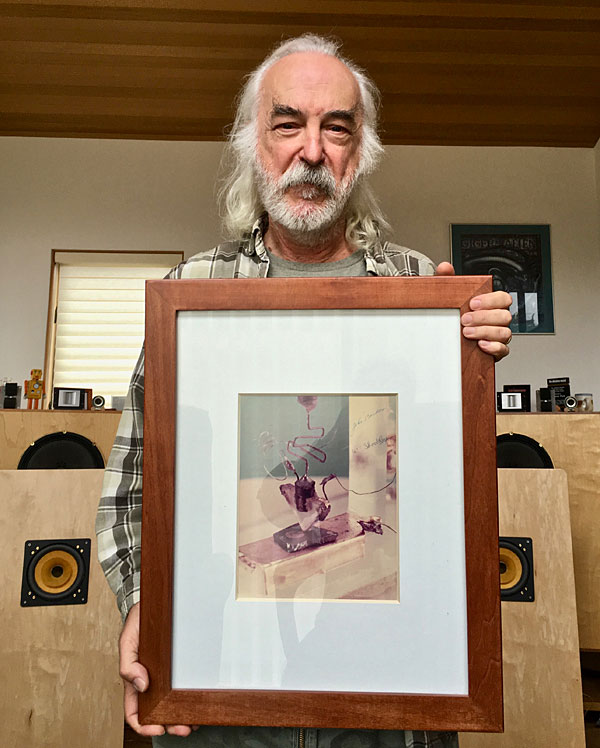| Columns Retired Columns & Blogs |
Excellent piece of writing- HR
I like the pictures of the "Master" at work. Or is is play?
Nelson Pass has that whole Rick Rubin (a different Zen master) vibe.
Siegfried Linkwitz
At Burning Amp, Nelson Pass and his friend Laurie Fincham delivered quiet memorials to loudspeaker designer Siegfried Linkwitz (1935–2018), who died September 11. Fincham read a poem he'd written, "Siegfried's Saga."
I'd known Linkwitz a little, and loved talking speakers with him, but nothing I can say here could match Michael Fremer's Pulitzer Prize–quality tribute in the September 2018 "Analog Corner."
I almost died
The address on the invitation read "Sea Ranch." I figured Nelson Pass must live on some scenic but long-defunct Hollywood movie set like Big Sky Ranch (footnote 3). But Sea Ranch is actually a planned, unincorporated community, established in 1964, that is the polar opposite of our East Coast dystopian sprawl. Though every inch of it looks wild and completely natural, it was all designed by a landscape architect. The houses have no paint and no eaves. There are no streetlights or stoplights, no utility poles or stores or gas stations. But there are deer and snakes and dogs and jackrabbits everywhere. Best of all, there are seals galore and whales offshore. A herd of sheep keep the grass cut low. This is where Nelson, Jill, and Jack live—where they stay near to the oceanic life force.
The exoticness of my Sea Ranch experience was intensified in the three hours it took to get there from Fisherman's Wharf. Approaching Sea Ranch along California's otherworldly, superscenic, supernarrow, death-at-every-curve Coastal Route 1 is dangerous: hairpin curves, high cliffs, and no guardrails. It's even more dangerous if you're driving with Bryan Stanton, who fancies himself a sport-racer complete with driving gloves, lead foot, and no sleep.
Pass had warned me: "It's not as bad driving up [north], because at least you're on the inside lane. It's going back [south] where you can die. You're on the outside lane, and one mistake—then total silence."
Stanton tried to calm me: "Don't worry, Herb—I am in control!"
I cried, I pleaded, I prayed aloud. It was night-dark with thick fog and sheets of rain. Giant out-of-control trucks careened toward us, their headlights on high. Stanton was doubling the speed limit. "We're gonna die!" I sobbed. He giggled, then sneered a dastardly sneer.
The next morning was bright, with light drizzle. Stirling Moss had told me not to wake him before 11am, so around 10am I walked from the guest house to the Nelson-Jill-Jack house. The first thing Pass showed me was his workbench. The first thing I stared at were the holes in the yellow sponges he uses to clean the tips of his three soldering irons. I saw a heat gun, and bits of circuit scattered everywhere. That's all I remember now, except that Nelson Pass seems to own nothing fancy. His living quarters are beautiful but conspicuously humble. His most notable possessions, besides a handsome dog and a spectacular ocean view, are hundreds of thousands of transistors.

Pass's work-study-listening room was filled with LPs, a Technics SL-1200 turntable, and stereo pairs of various full-range drivers mounted in a variety of birch-ply cabinets. His main studio speakers were vintage Tannoy 15" coaxials mounted in rear-loaded-horn cabinets. We listened to a two-way, open-baffle design featuring a Cube Audio 8" F8 Magus full-range driver powered by Pass's latest First Watt amplifier, the SIT-3. Below and behind the Magus's vertical baffle, mounted face-down on a small horizontal baffle about 5" above the floor, was a slot-loaded 15" Eminence woofer. The woofer was separated from the wide-open full-range driver by an LX Mini active crossover and driven by a First Watt F7 amplifier.

Confession: As much as I enjoy BBC minimonitors and Western Electric horns, I've always aspired to own a system exactly like Nelson Pass's open-baffle design. Problem is, I've experimented a lot with full-range drivers—including Western Electric 755As, Lowthers, Jordans, Fostexes, etc.—but had never found one I could live with. Until I visited Sea Ranch.
Immediately, those Pass creations made every two-way-with-dome-tweeter design sound closed-in. They made Quad 57s sound repressed. The Cube Audio F8 Maguses' treated-paper cones had an audible sound character (what driver doesn't?) but that character was extremely subtle, and distinctly all-natural. The Cube drivers were playing raw, with no dulling crossover between the amp terminals and speaker motor. No part of the reproduction process was hidden or suppressed. Imagine fast, direct, exceptionally see-through. Music was vivid and lively, but never too much so. Nelson Pass was getting more life and transparency from the Cube F8 Maguses and his own SIT-3 than I got from the same amp and any of the speakers in my home collection.
The sun beamed from the window behind my chair. I was listening, dreaming, feeling quite pleased to be in Nelson Pass's listening studio with wolf-eyed Jack lying on the floor before me, when Bryan Stanton arrived. "Nelson," he said, "what will Herb's readers think when they see your RadioShack wires?" I smiled. Pass smirked, then chuckled. "They'll think I don't want anyone else taking credit for my achievements."
Back in the main house, we sat on leather recliners, drank wine, and listened to music through Pass's smooth-as-silk Pass Labs big rig—while keeping one eye peeled for whales on the sun-sparkled ocean. (Stanton and Pass saw two or three; I was too busy petting Jack to notice.)

Home again
Before leaving for the left coast, I'd been midway through my review of the Nelson Pass–designed First Watt SIT-3 stereo amplifier, but already I knew it was doing a just-right/not-too-much job with second-harmonics: It delivered deep, airy spaces, dense images, and prize-winning timbres, but it was never thick or fuzzy. I therefore waited to try out Pass's H2 Harmonic Generator until after I'd installed a different Pass design, one with a more mainstream sound and lower amounts of second-harmonic distortion: the Pass Laboratories XA25.
With the H2 inserted between my preamp and the XA25, the system's sound changed noticeably. At first, I couldn't say what had changed—then I remembered that inserting this extra, unity-gain, phase-inverting stage had inverted my system's absolute phase. So I listened for a while to the effects of positive phase second-harmonic distortion. Compared to normal phase and no H2, the sound seemed drier and strangely duller, but also more detailed. Percussion was more percussive. Guitar strings felt more tightly strung. Flutes sounded sharper but less harmonically expansive.
Nelson Pass had said that H2 experiments should be conducted with "simple" musical program. He warned: with complex program, excessive second harmonic can do more harm than good.
Honoring his wish, I pulled out one of my favorite Alan Lomax recordings: Southern Journey, Volume 3: 61 Highway Mississippi—Delta Country Blues, Spirituals, Work Songs & Dance Music (CD, Rounder 1703), recorded with a single microphone. What Pass had said was true: singers and instruments seemed closer to that mike than before.
When I reversed my speaker leads, creating negative-phase second-harmonic distortion (still at the H2's original setting), everything got gentler, warmer, more distant, and more colorful—but not necessarily better. I missed the punch, but welcomed what I perceived as enhanced overtones and more natural-sounding voices.
Next, hoping I understood how the H2 worked, I used its little trim pot to lower the regulated voltage across the JFET's drain load resistor, from 15.6 to 15.1VDC. This raised the distortion and took the abovementioned negative-phase second harmonic even further. Crispness was further reduced. Music was still presented in a pleasurable manner—but I definitely liked it better at the higher voltage.
After "Louisiana," by Henry Ratcliff, and Mississippi Fred McDowell's "61 Highway Blues," I couldn't stop myself—I turned the JFET's drain voltage up to 16VDC. According to Pass, this should audibly reduce distortion. All I noticed was a rather unpleasant loss of tone color and spatial content.
When I removed the H2 from the circuit, my record-playing life immediately improved: that weird, dull feeling disappeared, replaced by the XA25 amplifier's signature transparency.

Gratitude
Hanging with Nelson Pass reminded me that the reproduction of recorded music is truly an entertaining illusion: "not dialysis!"
I've been following the work of Nelson Pass since his days with Threshold, and am forever a fan of his Aleph series amplifiers. I'm currently under the spell of his First Watt explorations. But now that I've sat and walked with him, I think I understand a little of why he's still searching for fresh possibilities, speculating on what we actually know vs what we think we know, and experimenting with amplifier circuits that lesser designers would dismiss as untenable. My hat is off and I am facing West.

Excellent piece of writing- HR
I like the pictures of the "Master" at work. Or is is play?
Nelson Pass has that whole Rick Rubin (a different Zen master) vibe.

"otherworldly, superscenic, supernarrow, death-at-every-curve Coastal Route 1 is dangerous"
Come on, this is a fantastic route. I had the opportunity to drive south and I enjoyed every minute of it :)

One interesting aspect of this: If you flip just the sign/polity of the second harmonic distortion, the only difference between the new waveform and the old is absolute phase/polarity.

If you flip just the sign/polity of the second harmonic distortion, the only difference between the new waveform and the old is absolute phase/polarity.
All the more interesting, then, that the subjective effect depends on the polarity of the 2nd harmonic distortion that you added.
Of course, if you look at the waveforms posted here, you can see that his box adds some higher harmonics as well (so that the net result of flipping the polarity of his added distortion is not quite an overall polarity-flip).
It's those higher harmonics that presumably are responsible for the perceived difference when you flip the polarity of the distortion.

Sorry, wait, no.
If the input signal is sin(ωt), adding some second harmonic yields an output signal
sin(ωt) ( 1 ± 2a cos(ωt) )
where the amplitude of the 2nd harmonic is "a" (a ~ 0.01 for Mr. Pass) and the ± corresponds to positive/negative polarity.
The choice of ± is not just a choice of overall polarity.

There's also a time shift, which of course makes no difference. Wanna see the math?

Unless your argument is that the phase is irrelevant (in which case, the polarity of the added 2nd harmonic distortion should have no audible effect), then I don't see how that changes things.
An arbitrary phase shift, ϕ, just interpolates between the two polarities (as ϕ ranges between 0 and π). But, as long as the amplitude of the added 2nd harmonic is small, there's no choice of its phase, ϕ, that has the effect of just inverting the resulting total waveform.

OK, I'll spell it out then. The time-shift I mean is (again, like the polarity inversion) absolute: The whole thing together is shifted by pi. Which obviously doesn't matter.
The only identity you need is sin(x) = - sin(x - pi). So, sin(wt) + a sin(2 wt) = - sin(wt - pi) - a sin(2 wt - pi)) = -sin(wt - pi) + a sin(2wt - 2pi) = -sin(wt - pi) + a sin(2(wt - pi)) = -(sin(wt-pi) - asin(2(wt-pi) ).
So you've shifted the whole spectrum together by pi and inverted it. QED.

Yes, an extra π phase shift in the 2nd harmonic is (obviously) equivalent to flipping the sign of a. I didn't realize that was what you meant.
I'll say again, though, that either relative phase doesn't matter (in which case, the sign of "a" should make no audible difference) or it does -- in which case your (frequency-dependent) time-shift matters.

I still feel like we're not communicating, but after this I've got to let this go. What I'm saying is that when you flip the polarity of the second harmonic, the only significant difference is that the overall sign of the waveform is reversed. (The whole waveform is also shifted by pi, but that obviously makes no difference.) There's nothing relative in any of this: It's a change in absolute polarity accompanied by a shift (of the whole waveform, NOT of the harmonic relative to the fundamental) by half a period of the fundamental, or a whole period of the second harmonic. Since, for pure tones, a time-shift of the whole waveform doesn't matter, the only significant difference is that absolute polarity is flipped. Here, I've reversed the sign of the second harmonic at 5 seconds.

Be Well,
Jim

We agree on the mathematical identity
sin(ω(t+π/ω)) + a sin(2ω(t+π/ω)) = - [sin(ωt) - a sin(2ωt)]
I'm sure we also agree on the even simpler identity
a sin(2ω(t+π/2ω)) = - a sin(2ωt)
If you believe the standard psycho-acoustic research that says that frequency-dependent time shifts of this sort are inaudible, then either of these identities is sufficient to conclude that flipping the polarity of the 2nd order harmonic should not make an audible difference. (In fact, the latter identity is "better" in that it applies to any harmonic distortion.)
Clearly, those who hear a difference between "+a" and "-a" cast doubt on the inaudibility of the frequency-dependent time shifts in either of these identities.
I was initially confused and thought you were claiming "+a" and "-a" were related by a frequency-independent time-shift (or no time-shift at all). Sorry.

This--that flipping the sign of the harmonic only affects absolute polarity (plus a phase shift) is true for all even harmonics.

"I'm trying to bring a little bit of every type of sauce into one type of sound ..... something that's really fresh." ............ Post Malone :-) .........

... a deeper soundstage and enhanced detail? Can you connect two of the H2 modules in series, with one set to add positive-phase distortion and the other set to add negative-phase distortion?
Is that an "audiophile approved" electrolytic capacitor in the signal path? Where's the film cap bypass?


I was expecting a flurry of responses to this piece.
Maybe they're coming, or, as I have been wrong many times in my life, this article hasn't yet stirred up the emotions/discussion I had thought...
Cheers,
Terry

... old news:
https://positive-feedback.com/audio-discourse/the-pass-h2-harmonic-generator/

"I was expecting a flurry of responses to this piece.
Maybe they're coming, or, as I have been wrong many times in my life, this article hasn't yet stirred up the emotions/discussion I had thought...
Cheers,
Terry"
After carefully reading the piece twice, I think HR was trying to play provocateur but we readers can see through it. There is really nothing new here. Everything in audio is a trade-off. Pick your poison.
Read more at https://www.stereophile.com/content/gramophone-dreams-26-nelson-pass-harmonic-distortion#bbGfLx9ig1JJsE80.99

I was wondering if the author could provide additional comment regarding the open baffle experience with the SIT3, CUBE Audio 8" driver and 15" Eminence woofer in the slot position in terms of imaging and bass response. Thank you in advance. I really enjoyed this article and enjoy your writing at large.